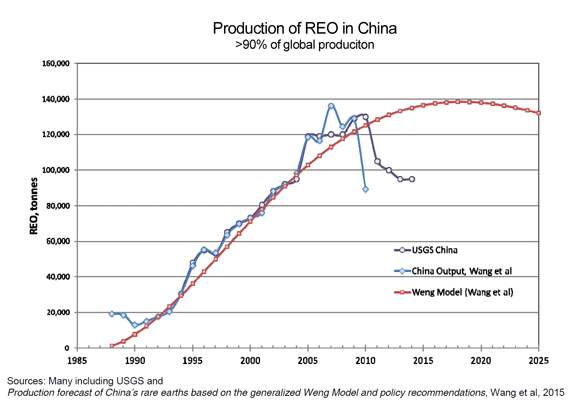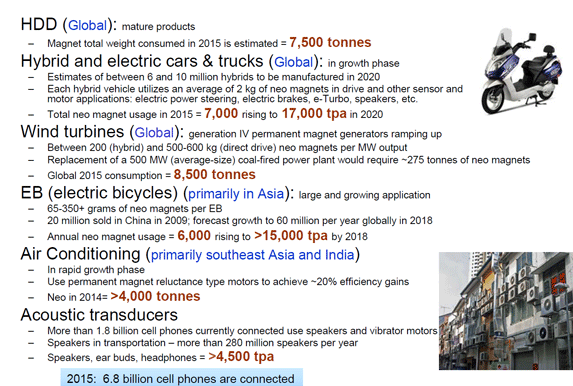Market outlook for rare earth permanent magnets presented at Magnetics 2016
April 5, 2016
There have been many notable milestones in the development of permanent magnet materials in recent years. These include the alnico family in the early 1930s, ferrite magnets in the 1950s, samarium-cobalt in the 1960s, and the more powerful rare earth-based NdFeB magnets developed in the mid-1980s. The latter now make up more than half of all permanent magnets based on value of sales.
Steve Constantinides, Director of Technology at Arnold Magnetic Technologies, recently presented a ‘market outlook’ for various types of permanent magnets at Magnetics 2016 held in Jacksonville, USA, where he reviewed the constituents, price and availability of the key materials which make up these materials, and how their future usage will depend on trends in key application areas.
Constantinides stated that of all the elements used in permanent magnets, rare earth oxides are the most problematic based on geographic limitations on sourcing. China still dominates this sector producing 90% of annual requirement of rare earth oxides, and also produces (and consumes) more than 80% of global permanent magnet production with almost inconsequential production in other regions. Even production in China is difficult to quantify with a sizeable gap said to exist between Chinese government production quotas and the rare earth magnets produced on the black market, claimed Constantinides.
Constantinides also reviewed the six major application areas for rare earth magnets, predominantly NdFeB, and their future prospects (Fig.1). Hard disk drives (HDDs) use compression bonded NdFeB permanent magnets in the spindle drive motor to spin the platter and sintered NdFeB magnets are used in the voice coil motor of HDDs. In 1990 more than 70% of all NdFeB magnets went into HDDs, and by 2015 the global tonnage of these magnets was estimated to be around 7,500 tonnes. However, HDDs are being challenged by solid state drives (SSDs) and Constantinides forecasts that the consumption of NdFeB magnets for this sector will fall by 2020.
The market for hybrid electric cars and trucks has not grown as fast as was forecast, representing less than 3% of total sales in the USA. However, this market is expected to continue growing with an increase in demand for NdFeB magnets for traction drive motors, and also for many other new uses for electric motors in vehicles such as electric power steering and electric braking. Another relatively new application is for stop/start technology where an electric motor functions both as the alternator and starting motor. Constantinides put the consumption of rare earth magnets in transportation at 7,000 tonnes in 2015 rising to 17,000 tones in 2020.
Wind turbines use sizeable quantities of NdFeB magnets for induction type generators and the redesign of generators to use more efficient direct drive or hybrid drive types is expected to see slightly decreased usage in this area in the future. Consumption in 2015 was around 8,500 tonnes of NdFeB magnets.
Electric bicycles (EBs) are now a substantial market for NdFeB with China and India being the biggest producers. India is expected to produce 60 million EBs by 2018 when the global tonnage of NdFeB magnets for this sector is forecast to reach 15,000 tonnes – up from 6,000 tonnes in 2015.
Air conditioning systems use 3 to 4 electric motors most of which now apply NdFeB permanent magnets. Estimated consumption was around 4,000 tonnes in 2014, a number which Constantinides expects to see grow, mainly in the South-East Asia and Indian markets.
Finally, Constantinides gave examples of where NdFeB magnets are used in speakers and vibrators of cell phones and smart phones and also in a host of speakers used in vehicles. Here the market is estimated to be more than 4,500 tonnes/year.
Forecasts for future growth in the application of NdFeB magnets is shown in Fig.2.

Fig.2 Both the blue and the purple lines indicate published (public) figures for REO production in China. The red chart line is the generalized Weng Model – a widely used quantitative model for “exhaustible resource” forecasting. It shows a period of rapid growth, peaking and then decline. (Courtesy Arnold Magnetic Technologies)
















